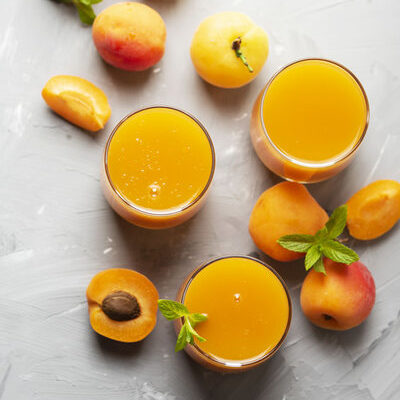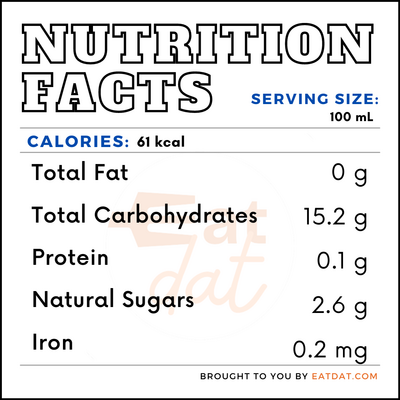
Apricot Juice
also known as Apricot Nectar
What is Apricot Juice?
Apricot juice is the liquid extraction of the apricot fruit of the Rosaceae family. This stone fruit is similar to the peach, but is smaller with yellow and orange skin.
- Apricot juice has been consumed since ancient times and has its origin in Armenia.
- The Latin word for apricot is “praecocquu” which means “precious”, a term that was given to this fruit as it ripens before many others.
Juices, like apricot, are becoming increasingly popular with worldwide consumption reaching 35,934 liters in 2018.
Some common ways to use apricot nectar include:
- Glazes
- Cocktails
- Sauces
- Brine
- Ice Cream
- Cakes
- Smoothies
- Jam
Origin of apricot juice
The apricot fruit is believed to have been originally domesticated in China. Archeological evidence shows that this fruit was also consumed in ancient Armenia. Apricots likely reached the Middle East when the Islamic empire, run by the conquering caliphs, transported them there from Central Asia between 750 and 1258 AD. In fact, when the Romans first learned of this fruit in 100 AD, they gave it the name Prunus armeniaca, as they believed it was originally from Armenia.
Apricots remain popular in the Middle East where they are often consumed in various forms and during religious periods. This fruit can be found fresh, dried, as well as in a paste or juice form all over the region. One famous apricot juice, known as Qamar Al-Din, is popularly consumed for breakfast or breaking the fast during the holy month of Ramadan. Today, this fruit juice is enjoyed all over the world and used in a variety of ways to add flavor to food in the kitchen.
Nutrition
Apricots and their juice are nutrient-rich and offer plenty of antioxidants. A 100-mL serving contains:

This juice can provide Vitamins A and C, as well as potassium, calcium, iron, and beta-carotene. Apricots also offer health benefits such as promoting eye health, boosting skin health, improving gut health, and protecting the liver. Although much of the healthy fiber is lost when this fruit is juiced, apricot juice is very hydrating and maintains most of its nutrients. However, some versions of this juice may contain added sugar, which if consumed in excess, can lead to heart disease and obesity.
Commercial Production
The commercial production of fruit juices, such as apricot juice, begins with sorting and washing freshly picked fruits. Then, the apricots are heated and a screw is inserted to easily remove the stone from the fruit. Then, the apricots are crushed to a pulp and their skin is separated from the flesh. After that, the pulpy flesh is squeezed using industrial machines to extract its juices. Finally, the apricot juice can be pasteurized or remain unpasteurized before it’s bottled, capped, labeled, and stored until sold.
Uses
Storing apricot correctly will ensure that your apricots juice is fresh and flavorful. The optimal temperature for storing these fruits is 31°F-32°F, anything lower and the fruit may freeze, which will affect its texture and taste. Apricots should be kept away from other fruits such as apples, plums, pears, or peaches as they release ethylene gas and speed up spoilage. Apricot fruit juice will taste best when freshly made, however you can also store it in an airtight container in the fridge. This juice should be consumed within 24 – 72 hours after juicing, as oxidation will render it undrinkable after that.
Apricot juice recipes
This fruit juice can be used to craft delicious drinks and dishes. Here are some recipes:
FDA Regulation
The Food & Drug Administration heavily regulates fresh fruits and how they should be cultivated, prepared, and packaged. The FDA regulates the production of juice, which it defines as the “aqueous liquid expressed or extracted from one or more fruits or vegetables, purees of the edible portions of one or more fruits or vegetables”. The FDA stipulates that products that include apricot juice on their label must contain a concentration of at least 11.7% apricot juice.
References
Koptyug, Evgeniya. “Worldwide Consumption of Fruit Juice and Fruit Nectar by Region 2017-2018.” Statista, Statista, 9 Oct. 2019, www.statista.com/statistics/421179/worldwide-consumption-of-fruit-juice-and-fruit-nectar-by-region/.
“Apricot.” Encyclopædia Britannica, Encyclopædia Britannica, Inc., 13 Nov. 2019, www.britannica.com/plant/apricot.
Denker, Joel. “’Moon Of The Faith:’ A History Of The Apricot And Its Many Pleasures.” NPR, NPR, 14 June 2016, www.npr.org/sections/thesalt/2016/06/14/481932829/moon-of-the-faith-a-history-of-the-apricot-and-its-many-pleasures?t=1601042063764.
“Tree Fruit: Apple, Pear, Peach, Plum, Apricot, and Plums.” Fao.org, Food and Agriculture Organization of the United Nations, www.fao.org/3/Y2515e/y2515e15.htm.
“CFR – Code of Federal Regulations Title 21.” Accessdata.fda.gov, U.S. Food & Drug Administration, 1 Apr. 2019, www.accessdata.fda.gov/scripts/cdrh/cfdocs/cfcfr/CFRSearch.cfm?CFRPart=101.
